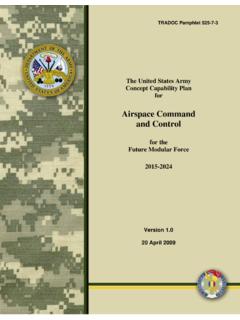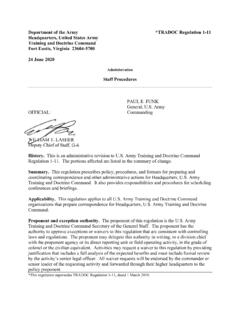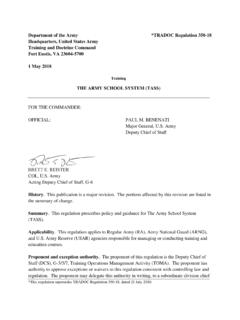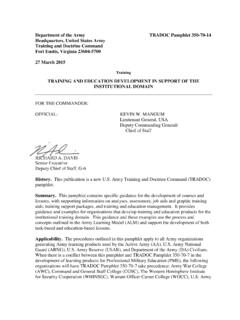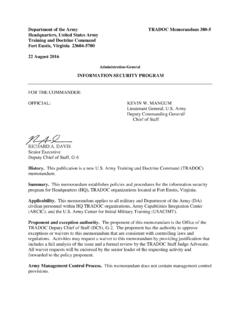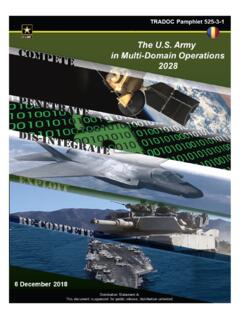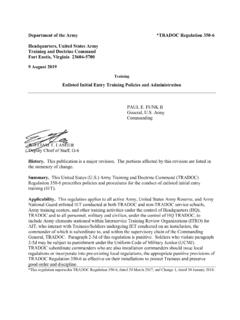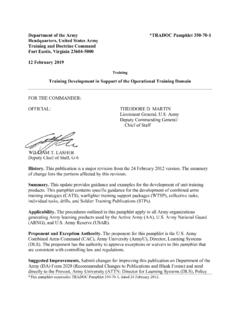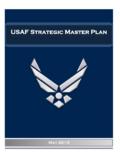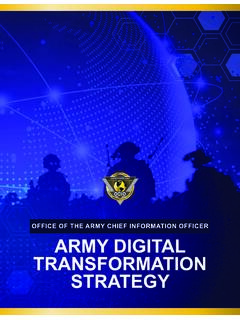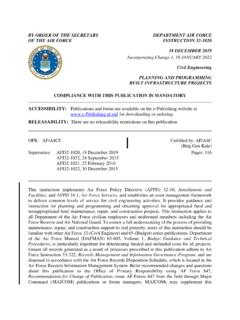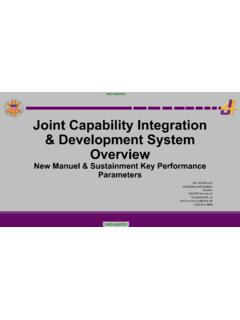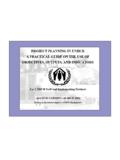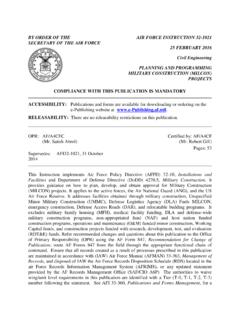Transcription of TRADOC Pamphlet 525-8-2 - United States Army
1 TRADOC Pamphlet 525-8- 2 ii This page intentionally left blank TRADOC Pamphlet 525-8- 2 iii Foreword From the Commanding General Army Training and Doctrine Command The Army is a learning organization. Therefore, the Army s vision is to immerse Soldiers and Army civilians in a progressive, continuous, learner-centric, competency-based learning environment from their first day of service. Within this environment, the Army applies a comprehensive program combining training, education, and experience to develop agile, adaptive, and innovative Soldiers, Army Civilians, and teams able to fight against capable and elusive enemies and win in a complex world. The Army intends to focus on the learner t o strengthen and develop competencies that enable leaders to build trusted, cohesive teams capable of winning in all environments and across all domains.
2 The learning environment will consist of tough and realistic conditions and include joint, interorganizational, and multinational components to prepare leaders for 2025 and beyond. Building on the enduring foundation of more than 24- years of preparation to defend the Nation, the Army looks to the future through its concept development process. The documents within the Army Concept Framework describe fundamental ideas about future Army operations and key required capabilities. United States ( ) Army Training and Doctrine Command ( TRADOC ) Pamphlet (TP) 525-8- 2, The Army Learning Concept for Training and Education 2020-2040 (ALC-TE) is a leadership-directed concept that outlines the key characteristics and elements required to build the future Army learning environment. The ALC-TE combines thoughts from both TP 525-8- 2 (Army learning concept) and TP 525-8- 3 (Army training concept) into one document that supersedes both.
3 The ALC-TE provides the Army visualization of the future learning environment. It describes a continuous, adaptive learning enterprise that facilitates a career-long continuum of learning. The ALC-TE creates the conditions necessary for the Army to develop trained and capable Soldiers and Army civilians with the knowledge and skills needed to generate and sustain trained teams that improve and thrive under conditions of ambiguity and chaos. This concept focuses the Army s efforts to enhance learning in Army classrooms, in the field, and through self-development. Future Army training and education will help Army leaders think clearly about future armed conflict across the human dimension, learn about the future by optimizing leader development, analyze learning outcomes, gaining intellectual and cognitive advantages over future adversaries, and implement outcomes to refine training and education.
4 DAVID G. PERKINS General, Army Commanding TRADOC Pamphlet 525-8- 2 iv This page intentionally left blank Department of the Army * TRADOC PAM 525-8- 2 Headquarters, United States Army Training and Doctrine Command Fort Eustis, Virginia 23604-5763 13 April 2017 Military Operations THE ARMY LEARNING CONCEPT FOR TRAINING AND EDUCATION 2020-2040 DAVID G. PERKINS General, Army Commanding RICHARD A. DAVIS Senior Executive Deputy Chief of Staff, G-6 History. This major revision consolidates Army Training and Doctrine Command ( TRADOC ) Pamphlet (TP) 525-8- 2, United States Army TRADOC s Army Learning Concept, change 1, and TP 525-8-3, Army Training Concept, into a single concept, TP 525-8- 2, the Army Learning Concept for Training and Education, 2020-2040.
5 Because this publication is revised extensively, not all changed portions have been highlighted in the summary of change. Summary. TP 525-8- 2 describes a future Army learning environment that meets the need to develop adaptable, thinking Soldiers and Army civilians with the learning competencies to generate and sustain trained teams. The concept focuses on individual learning to enable individualized and career-long learning that is integrated seamlessly with unit training capabilities to support the conduct of joint combined arms operations. Applicability. This concept applies to all Department of the Army (DA) activities that develop doctrine, organizations, training, materiel, leadership and education, personnel, facilities and policy (DOTMLPF-P) capabilities.
6 This concept informs subsequent supporting concepts and the Joint Capabilities Integration and Development System process. It supports Army capabilities development processes described in TRADOC Regulation 71-20 and functions as a conceptual basis for developing concepts related to the future force within DOTMLPF-P. It also supports Army training and leader development described in Army Regulation 350-1. This document supersedes TP 525-8-2 , dated 20 January 2011, TP 525-8-2 Change 1, dated 11 June 2011, and TP 525-8-3, dated 7 January 2011. TRADOC Pamphlet 525-8- 2 2 Proponent and supplementation authority. The proponent of this Pamphlet is the Director, Army Capabilities Integration Center (ARCIC). The proponent has the authority to approve exceptions or waivers to this Pamphlet that are consistent with controlling law and regulations.
7 Do not supplement this Pamphlet without prior approval from Director, ARCIC, attention Joint and Army Concepts Division (ATFC-ED), 950 Jefferson Avenue, Ft. Eustis, VA 23604-5763. Suggested improvements. Users are invited to submit comments and suggested improvements using DA Form 2028 (Recommended Changes to Publications and Blank Forms) to Director, ARCIC (ATFC-ED), 950 Jefferson Avenue, Fort Eustis, VA 23604-5763 with a copy provided to Provost, Army University, 201 Auger Avenue, Fort Leavenworth, KS 66027. Availability. This publication is approved for public distribution and is available on the TRADOC homepage at Summary of Change TRADOC Pamphlet 525-8- 2 The Army Learning Concept for Training and Education This revision, dated 13 April 2017- o Integrates United States Army Training and Doctrine Command Pamphlets 525-8- 2, its Change 1, and 525-8- 3 into one concept.
8 O Standardizes concept timeframes to 2020-2040. o Revises the Foreword. o Updates title (title changed throughout), introduction (chap 1), conclusion (chap 4). o Updates assumptions (para 1-8). o Replaces conceptual foundation with the operational context (chap 2) and meeting the challenges with the military problem and components of the solutions (chap 3). o Describes how Army forces conduct learning as part of globally integrated operations consistent with the Capstone Concept for Joint Operations: Joint Force 2020, United States Army Training and Doctrine Command Pamphlet 525-3- 0, The Army Capstone Concept, United States Army Training and Doctrine Command Pamphlet 525-3-1, The Army Operating Concept: Win in a Complex World, and The Army Human Dimension Strategy 2015 (throughout). o Updates references (app A).
9 O Re-letters required capabilities appendix. Updates required capabilities and describes how the Army will develop the learning (app B). TRADOC Pamphlet 525-8- 2 3 o Adds appendix that identifies how Army training and education-related science and technology will support implementation of the concept (app C). o Adds appendix that identifies risks associated with adopting this concept and ways to mitigate risks (app D). o Deletes appendices addressing proposed Army Learning Concept 2015 actions, 21st century Soldier competencies, current United States Army Training and Doctrine Command learning environment, and career span implications. TRADOC Pamphlet 525-8- 2 4 This page intentionally left blank TRADOC Pamphlet 525-8- 2 5 Contents Page Foreword .. iii Chapter 1 Introduction.
10 7 1- 1. Purpose .. 7 1- 2. References .. 7 1- 3. Explanation of abbreviations and terms .. 7 1- 4. Linkage to TRADOC Pamphlet (TP) 525-3- 0 .. 7 1- 5. Linkage to TP 525-3- 1 .. 8 1- 6. Linkage to The Army Human Dimension Strategy .. 8 1- 7. Background .. 8 1- 8. Assumptions .. 9 Chapter 2 Operational Context .. 9 2- 1. Introduction .. 9 2- 2. The future learning environment .. 11 2- 3. Drivers of agile change in Army learning .. 13 Chapter 3 Military Problem and Components of the Solution .. 14 3- 1. Military problem .. 14 3- 2. Central idea: Adaptive and continuous learning .. 15 3- 3. Solution synopsis: Career-long, learner-centric approach to training and education .. 16 3- 4. Individual and collective learning: Optimizing human performance .. 19 3- 5. Learning infrastructure development: An appropriate environment for learning.
